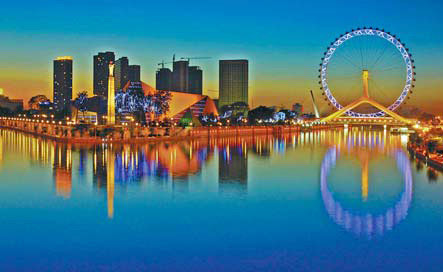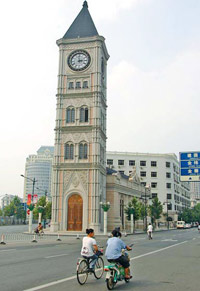Just the ticket to Tianjin
Updated: 2011-08-04 13:12
By Chitralekha Basu (China Daily)
|
|||||||||||
 |
|
Ancient Culture Street is a 21st century replica of what downtown Tianjin might have looked like about 100 years ago. |
 |
|
Ultra-modern high-rises and the giant Ferris wheel, modeled after the London Eye, dot Tianjin's twinkling skyline at night |
An expat colleague from the United States takes the Beijing-Tianjin express train every other month. It's the sheer thrill of covering a 100 km distance in under 30 minutes, she says. The seats are well spaced, with leg room comparable to business class seating on an international flight, the washrooms are large and spiffy and the journey is super-quick. Not that the fastest train ride linking two megalopolises anywhere in the world is the only thing to recommend about a trip to Tianjin.
Here is a place where it's like taking a step into one century and tumbling into another, experiencing a dramatic change of landscape, sensibilities and ambience, all in the blink of an eye.
The best way to get a taste of journeying across time zones is by hopping on to one of the liners ferrying passengers along the Haihe River.
The cruise will take you past clusters of early 20th century European-style buildings with red awnings, belonging to the Italian Concession area, set off against the grand and sprawling crescent-shaped Tianjin City Planning Exhibition Center, opened as recently as 2009.
The Century Clock, a stone's throw from Tianjin Railway Station, which comes with a quaint S-shaped pendulum and bronze motifs symbolizing the 12 zodiac signs, marks the beginning of Tianjin's trade relations with other nations during the mid-19th century.
 |
|
European-style buildings can be found in the city's Italian concession area |
For long the commercial gateway to northern China and a significant treaty port since the conclusion of the Second Opium War in 1860, Tianjin today is a curious amalgam of architectural styles. From Ming dynasty (1368-1644) courtyard houses, constructed on the lines of Chinese theory to classic Victorian and baroque in the concession areas to Chinese-Western hybrid styles - villas with octagonal doorways but domed roofs - the city has it all.
The Italian concession area, to which the Austro-Hungarian occupied area was added after World War I, doubling its size, is probably the most spectacular and lively among the erstwhile legation quarters.
Cafeterias spill out on the cobblestone roads, fountains spray the passer-by with mild jets of water, while bronze and marble sculptures of lovers and musicians compete for attention with their real-life counterparts.
Once the home of Chinese ideologue Liang Qichao and playwright Cao Yu, the Italian concession area today serves as a permanent stage for impromptu performances by rock groups, buskers, fashionistas sporting blue wigs and gothic make-up and couples in bridal gowns and tuxedoes, posing for a photo shoot.
We had a lavish lunch at Tianjin Goldin Metropolitan Hotel, hosted by Tianjin municipal information office, between lessons in the art of wielding a polo mallet. Derek Reid, former Australian national polo team captain, had sold his horse to the Metropolitan's Polo Club and then followed her to China. He now leads the team of professionals at the club.
The facilities are as big as they are luxurious, spread out over 898,000 square meters in Tianjin's Binhai Hi-Tech Park. The club also holds the distinction of organizing Asia's first snow polo tournament, but we didn't get to see much on-field action, in the height of summer.
The Shi family residence in Yangliuqing, in Tianjin's western suburbs, was built originally in 1875. Yangliuqing used to be the seat of the famous Spring Festival art, which combines techniques of both applying paint and printmaking.
The prosperous Shi family amassed its collection, which is now on display in their courtyard house-turned-museum of folk art. The most intriguing piece of art in this compound, sprawled out across 10,000 square meters, is an obelisk of a jade cabbage, a totem only the super-rich were entitled to keep in the household.
Ancient Culture Street is a 21st century replica of what downtown Tianjin might have looked like about 100 years ago. The alleys are bursting at the seams with shops selling standard Chinese souvenirs - calligraphy, brown and blue tea sets, turquoise jewelry, and busts of national heroes, from Chairman Mao Zedong to Yao Ming.
The lure of striking a good bargain is quite infectious, even if you're not too sure what to do with the cartload of goodies you've picked up dirt-cheap (my colleague got a set of four dried gourd shells for 93 US cents)!
There's a lot of art in action here. Candy makers whip up luminous edibles in elaborate cobweb-like designs. People have their silhouettes scissored out of black paper in a jiffy. A herb salesman pipes up, "Awalaa hoon" ("I am a vagabond") - a song from an early 1950s movie which has since come to represent everything Indian in Chinese popular imagination - as soon as he sets his eyes on me, a conspicuous South Asian face in a highly-multicultural crowd.
I was never a huge fan of food made from dough but since visiting the Gou Bu Li Bao Zi in Tianjin, I am having second thoughts. It's a 150-year-old brand that now has outlets in the United States, Japan and South Korea. Their soup-filled dumplings melt in the mouth and slide smoothly down the gullet but do not leave the slightest trace of grease.
And do give Tianjin's generic fried dough twists a shot. Low on sugar, high on crunchiness, their perfectly braided forms appeal as much to the eye as to one's taste buds. I am planning to string some of these as Christmas decorations.